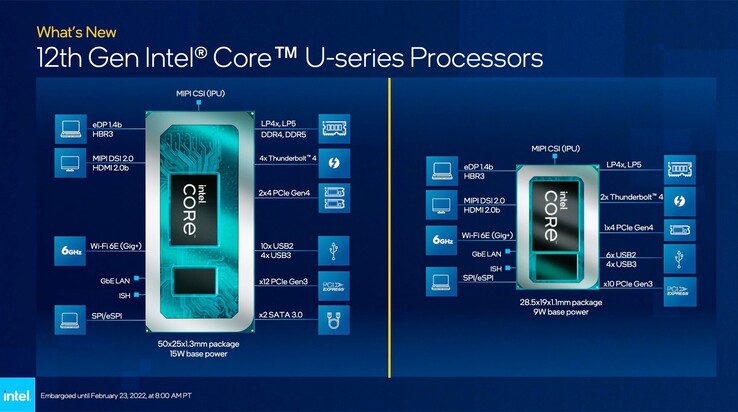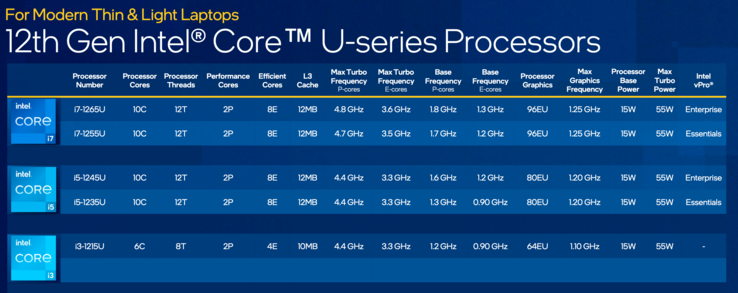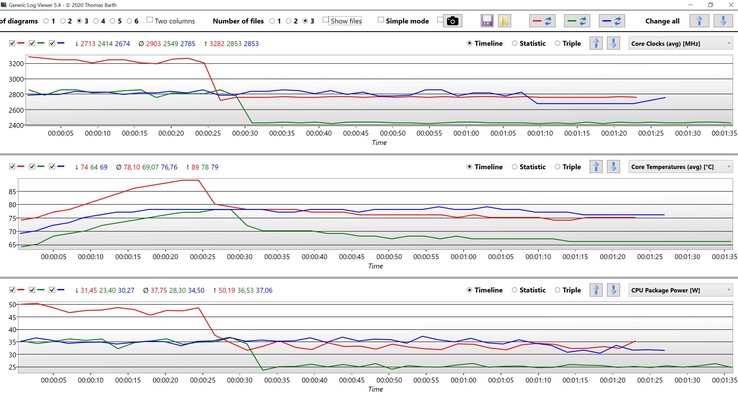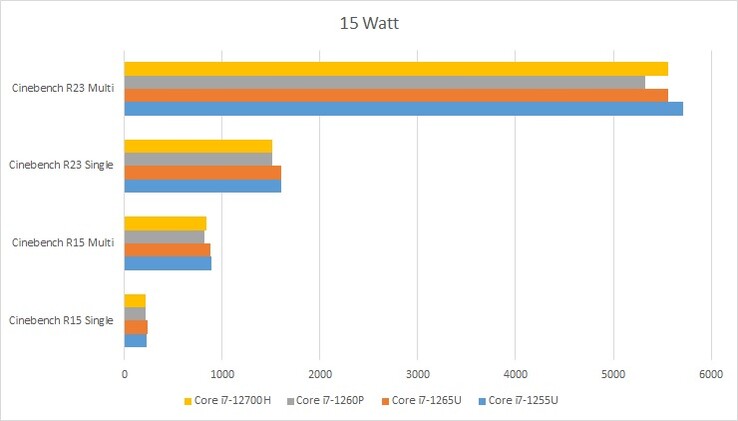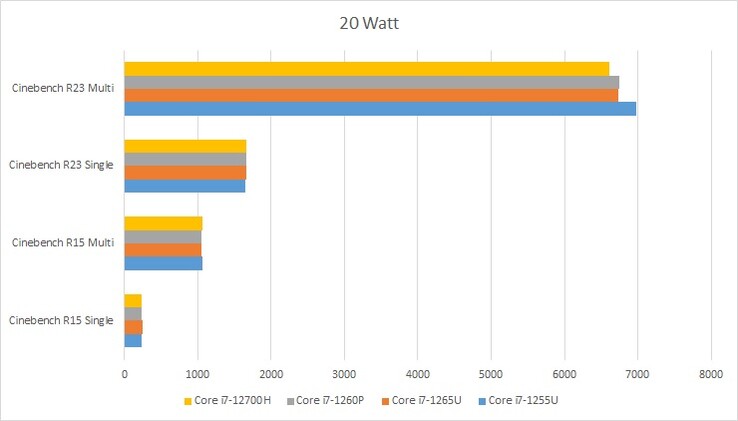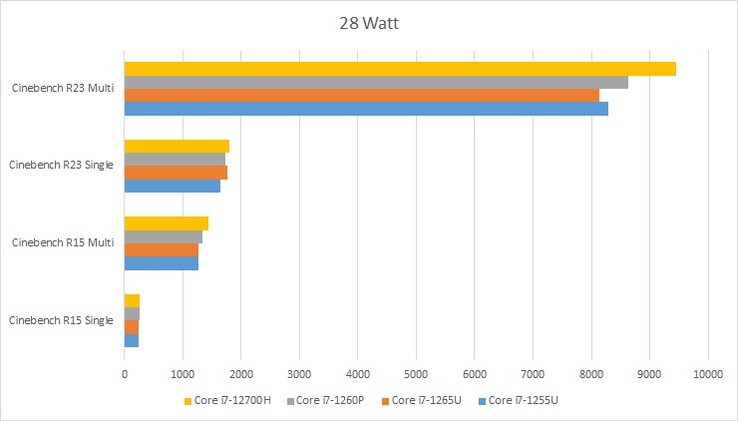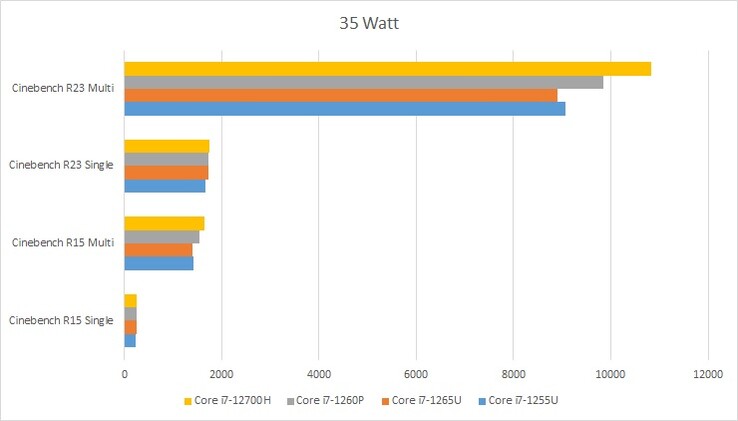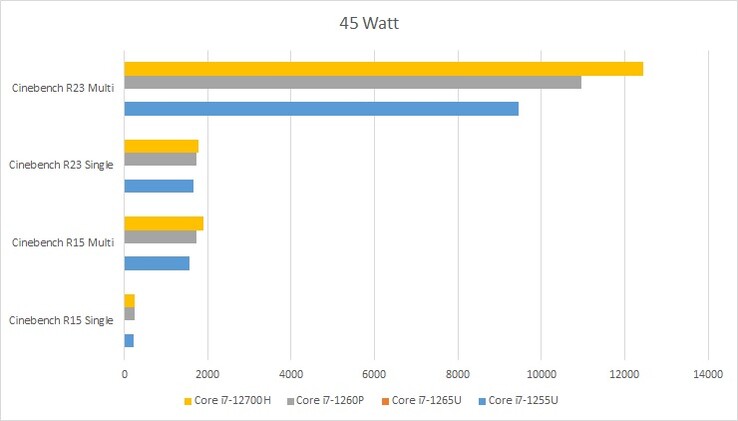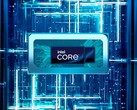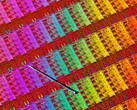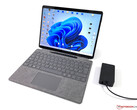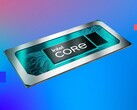Intel Alder Lake-U Review - The fine line between Efficiency and insufficient Performance
Intel’s 12th generation line-up of mobile processors uses a hybrid architecture consisting of performance and efficiency cores with four performance classes in total. In addition to the familiar models Alder Lake-U (15W) and Alder Lake-H (45W), there are new additions called Alder Lake-P (28W) and Alder Lake-HX for gamers and content creators at the upper end of the performance spectrum.
Today we have a closer look at the Alder Lake-U processors, which are available for a couple of months now. In addition to the performance (single-core and dual-core) and the range of performance, we will obviously check the efficiency and compare with CPUs from Apple and AMD as well. We also want to find our when it makes sense to use a potentially faster chip from the Alder Lake-P or even Alder Lake-H series.
The performance of the integrated GPU is not our focus though, since there are only a couple of changes in terms of clock speeds. The Iris Xe Graphics G7 is otherwise still the same iGPU we know from the previous CPU generation.
Overview Alder Lake-U
There are two different model lines with the designation Alder Lake-U, which are using completely different chips. In addition to the “regular” version with a nominal TDP of 15 Watts and a die size of 50 x 25 x 1.3 mm (identical to Alder Lake-P) there are also 9W models, which are actually smaller (28.5 x 19 x 1.1 mm) and are designed for even more compact laptops/convertibles. These two lines also differ in terms of features, but we do not want to go into details here and focus on the 15W models like the Core i7-1265U and Core i7-1255U instead.
Intel still classifies these CPUs as 15W chips, but the U-series CPUs have not really been 15W for quite a while now. Due to additional cores (especially during the transition from dual-cores to quad-cores), the CPUs required more energy. Intel nowadays calls this value PBP – Processor Base Power – which allows much higher power limits. This already clearly evident for the 9W CPUs, which can consume up to 29W. The regular 15W chips like the Core i7-1265U can even consume up to 55W of power.
The U-series Core i5 and Core i7 chips offer two fast Performance cores and eight Efficiency cores (total of 12 threads), so two performance cores fewer compared to most Alder Lake-P chips (like the Core i7-1260P). When such a processor can use a lot of energy, the two P-cores will reach very high clocks, but the efficiency quickly decreases above 4 GHz and the additional performance is low. The performance cores also consume a lot of power in single-core scenarios, which can quickly result in increased fan activity when you have a thin laptop with limited cooling capabilities, even in short peak load scenarios (when you launch an application, for example). We already noticed this behavior during some of our reviews and Alder Lake laptops tend to have more fan activity compared to similar last-gen laptops with 11th gen Tiger Lake CPUs.
Review Settings
We start with the single-core and multi-core performance of the Alder Lake-U laptops we have tested so far (Core i7, 15W PBP). Our efficiency measurements are performed with an external monitor attached so we can eliminate the influence of the integrated display.
Finally, we will compare two Alder Lake-U chips (Core i7-1255U in the Microsoft Surface Pro 9 & Core i7-1265U in the HP ZBook Firefly 14 G9) with the Core i7-1260P in the Lenovo ThinkPad T14 G3 as well as the Core i7-12700H in the HP ZBook Power 15 G9 at fixed power limits (adjusted via Throttle Stop software). We check the results at 15, 20, 28, 35, and 45W.
Please note that there can always be slight efficiency differences even when you have the same chips, but our results are still a good indicator. The Core i7-1255U in the Surface Pro 9, for instance, seems to be a very efficient chip, the Core i7-1260P in the ThinkPad T14 G3 on the other hand not.
Single-Core Performance & Efficiency
After all our tests so far, it is evident that Intel’s P-cores currently have an advantage compared to AMD and Apple in terms of raw performance. However, the Core i7-1265U (4.7-4.8 GHz) requires around 21 Watts for the full single-core performance, while the Core i7-1255U (4.5-4.6 GHz) is a bit more efficient at 17-20 Watts. If a device does not manage this power level, the single-core performance is not better compared to the current AMD Ryzen 7 6800U or Apple's M2.
If the performance core can utilize its full potential, we can see an advantage of up to 20 % over the competition. All in all, the Alder Lake-U chips offers very good single-core performance and there is no disadvantage compared to the faster Alder Lake-P or even Alder Lake-H processors, even though the require a bit more power (~22-24W in our measurements).
A look at the efficiency shows that the Core i7-1255U performs very well and is even ahead of the AMD Ryzen 7 Pro 6850U. The Intel chip benefits from its lower maximum Turbo clocks compared to the Core i7-1265U and it is more efficient. Both the P- and H-series CPU fall behind du to their higher consumption figures. Apple is still miles ahead in terms of efficiency with a single-core consumption of little more than 5W on its current M2 processor.
| Power Consumption - Cinebench R23 Single Power Efficiency - external Monitor | |
| Apple M2 | |
| Apple M2 | |
| Intel Core i7-1255U | |
| AMD Ryzen 7 PRO 6850U | |
| AMD Ryzen 7 PRO 6850U | |
| AMD Ryzen 7 6800U | |
| Intel Core i7-1265U | |
| Intel Core i7-1260P | |
| Intel Core i7-1260P | |
| Intel Core i7-1260P | |
| Intel Core i7-12700H | |
Multi-Core Performance & Efficiency
Our multi-core tests show bigger differences, because the fastest Alder Lake-U (Core i7-1255U, Surface Pro 9) is 55 % faster than the supposedly superior Core i7-1265U in HP’s Elite Dragonfly G3. Intel only manages to keep up with AMD’s current U-series chips (usually running at 25W) in multi-core benchmarks with much more power. For comparison: The Core i7-1255U consumes almost 50W and the Core i7-1260P in the ThinkPad T14 G3 even more than 50W.
This is also evident when we look at the efficiency chart, where Apple's M2 is once again at the top followed by the AMD Ryzen chips. All the Alder Lake CPUs are falling behind.
One more aspect that should not be overlooked is that the efficiency results should even be a bit worse when Alder Lake-U and P CPUs are operated at high power limits, because the power adapters are sometimes a limitation. This means the laptops has to use the internal battery for a short time as well to cover the high power consumption. We measure the power consumption at the PSU, so this aspect is not included in our measurements.
| Power Consumption - Cinebench R23 Multi Power Efficiency - external Monitor | |
| Apple M2 | |
| Apple M2 | |
| AMD Ryzen 7 PRO 6850U | |
| AMD Ryzen 7 PRO 6850U | |
| AMD Ryzen 7 6800U | |
| Intel Core i7-1260P | |
| Intel Core i7-1260P | |
| Intel Core i7-1255U | |
| Intel Core i7-1260P | |
| Intel Core i7-1255U | |
| Intel Core i7-1265U | |
This is an aspect where we also have to criticize the manufacturers, because it just does not make much sense to operate a U-series processor at 50 Watts. The temperatures are rising extremely quickly, which will require the fan. We tested this with the HP ZBook Firefly 14 G9 with the Core i7-1265U. The default settings of 55/33W result in a CB R23 Multi score of 9043 points. If we set the limit manually to 35W, however, the CPU can maintain this value longer and the result is just marginally lower at 8902 points, but the fan is quieter. The performance will drop by around 12% with 35/25W, but the fan will be even quieter, which is often more important for customers in everyday situations.
Alder Lake-U vs. Alder Lake-P vs. Alder Lake-H
We want to find out the optimal power range for the Alder Lake-U processors and when it makes sense to use an Alder Lake-P chip with two additional performance cores. For this test, we used the following four processors at locked power limits (via Throttle Stop): Core i7-1255U, Core i7-1265U, Core i7-1260P & Core i7-12700H.
Performance at 15 Watts
The two U-series CPUs have a slight advantage running at 15W, both in single-core as well as multi-core scenarios. However, the gap is not huge and the lower core clocks are almost balanced by the higher core count, even at 15W.
| Core i7-1255U | Core i7-1265U | Core i7-1260P | Core i7-12700H | |
|---|---|---|---|---|
| Cinebench R15 Single | 231 points | 236 points | 217 points | 214 points |
| Cinebench R15 Multi | 896 points | 885 points | 815 points | 839 points |
| Cinebench R23 Single | 1600 points | 1600 points | 1513 points | 1517 points |
| Cinebench R23 Multi | 5714 points | 5559 points | 5321 points | 5563 points |
Performance at 20 Watts
The single-core performance of the four processors is virtually identical at 20W and only the Core i7-1255U can maintain a small advantage in multi-core tests.
| Core i7-1255U | Core i7-1265U | Core i7-1260P | Core i7-12700H | |
|---|---|---|---|---|
| Cinebench R15 Single | 235 points | 248 points | 238 points | 240 points |
| Cinebench R15 Multi | 1062 points | 1054 points | 1050 points | 1061 points |
| Cinebench R23 Single | 1654 points | 1658 points | 1669 points | 1665 points |
| Cinebench R23 Multi | 6972 points | 6733 points | 6747 points | 6615 points |
Performance at 28 Watts
Our tests at 28W show that the Core i7-1255U does not manage higher single-core results. Thanks to its slightly lower Turbo clocks, it can already utilize its full single-core performance at 20W while the other three processors can improve their scores a bit (consumption between 21-25W). The Core i7-12700H already has an advantage over the Core i7-1260P, which is also faster than the two U-series chips. We can conclude that it does not make much sense to use an Alder Lake-U processor in a laptop where the cooling solution can handle 25W.
| Core i7-1255U | Core i7-1265U | Core i7-1260P | Core i7-12700H | |
|---|---|---|---|---|
| Cinebench R15 Single | 238 points | 249 points | 260 points | 255 points |
| Cinebench R15 Multi | 1278 points | 1271 points | 1337 points | 1438 points |
| Cinebench R23 Single | 1646 points | 1761 points | 1724 points | 1793 points |
| Cinebench R23 Multi | 8291 points | 8132 points | 8629 points | 9451 points |
Performance at 35 Watts
The disadvantage of the Alder Lake-U processors is getting even bigger at 35W, while the Core i7-12700H can increase the gap over the Core i7-1260P.
| Core i7-1255U | Core i7-1265U | Core i7-1260P | Core i7-12700H | |
|---|---|---|---|---|
| Cinebench R15 Single | 236 points | 247 points | 261 points | 253 points |
| Cinebench R15 Multi | 1415 points | 1406 points | 1550 points | 1657 points |
| Cinebench R23 Single | 1660 points | 1733 points | 1740 points | 1757 points |
| Cinebench R23 Multi | 9066 points | 8902 points | 9837 points | 10832 points |
Performance at 45 Watts
Running at 45W clearly shows a big difference between the CPUs and that the cores are very inefficient at very high clocks. Compared to 35W, the Core i7-1255U (we could not test the i7-1265U at sustained 45W) is only 4% faster despite 28% more energy. The decision between the Core i7-1260P and the Core i7-12700H is also very simple since the H-series CPU has a big advantage thanks to its six P-cores.
| Core i7-1255U | Core i7-1260P | Core i7-12700H | |
|---|---|---|---|
| Cinebench R15 Single | 237 points | 260 points | 257 points |
| Cinebench R15 Multi | 1554 points | 1737 points | 1889 points |
| Cinebench R23 Single | 1650 points | 1742 points | 1789 points |
| Cinebench R23 Multi | 9450 points | 10970 points | 12442 points |
Power Consumption Idle
In addition to the raw performance, we also checked the power consumption of the four Alder Lake processors while idling with default power limits. All the Windows power settings were identical across the four devices and we only analyzed the CPU Package Power during a two-minute period. The Core i7-1255U is once again very efficient with an average consumption of less than 1 Watt, while the other three CPUs are hovering around 1.5-1.7 Watts (the Core i7-1260P even consumes a bit more power than the Core i7-12700H).
Power Consumption Web Browsing
Our Wi-Fi test opens a different website every 30 seconds and we recorded one loop with a total length of 5 minutes. The processors are very close overall, only some websites stress the CPUs more. The average results after 5 minutes are 2.5W (Core i7-1255U), 3.7W (Core i7-1265U), 4.3W (Core i7-1260P) and 6W for the Core i7-12700H (even though the gap is mainly caused by the last website).
Verdict - Alder Lake-U makes sense, but Intel should limit the TDP range
Our measurements and benchmark scores show that Alder Lake-U processors can make sense, but both Intel as well as notebook manufacturers make it rather difficult for the customer. There are multiple factors for this, starting with the sheer number of Intel CPUs in the mobile segment. Intel should also specify a smaller TDP range and better differentiate the CPU classes. It just does not make much sense to run a Core i7-1255U at 50W when a Core i7-1260P can be limited to 25 or just 20 Watts (in the case of the Samsung Galaxy Book2). Stricter limitations could avoid this issue completely. The U-series CPUs could be limited in the range between 15-25W, the P-series between 25-40W and the H-series could start at 40W.
The notebook manufacturers should pay more attention as well. It does not make much sense to run a U-series CPU at up to 55W only because its possibly. The additional energy is pretty much wasted, but results in more fan activity. We have clearly shown that you will hardly lose any performance with reduced power limits, but the user will benefit from lower emissions in return.
The wide range of power settings is a problem for users, because the CPU performance can vary by wide margins. The Alder Lake-U processors work the best up to 25 Watts, and manufacturers should switch to Alder Lake-P chips when the cooling can handle more heat. AMD’s U-series processors are much more efficient in multi-core scenarios, but the availability is still limited.
Compared to AMD (like the Ryzen 7 6800U), Intel still has a performance advantage in single-core load scenarios. However, AMD is usually ahead in multi-core tests, especially when you look at the efficiency. Apple is still in a completely different league with its M1 and M2 CPUs, especially when you only stress one core. Both AMD and Apple also have an advantage in terms of iGPU performance compared to the familiar Intel Iris Xe Graphics G7.
Intel has already announced its new Raptor Lake processor line-up ad we expect the first laptops in the next couple of weeks. However, there are no major changes for the mobile processors (U P & H-series) except for some clock improvements. The other specs including the number of cores, the integrated GPU as well as the power limits are identical. There are some optional additional features, but we only expect small improvements in terms of performance and efficiency.


 Deutsch
Deutsch English
English Español
Español Français
Français Italiano
Italiano Nederlands
Nederlands Polski
Polski Português
Português Русский
Русский Türkçe
Türkçe Svenska
Svenska Chinese
Chinese Magyar
Magyar
